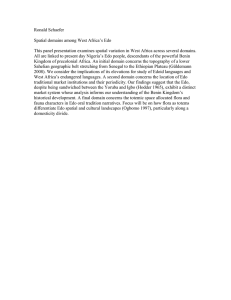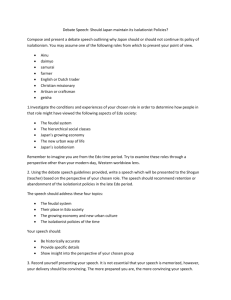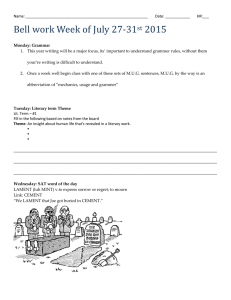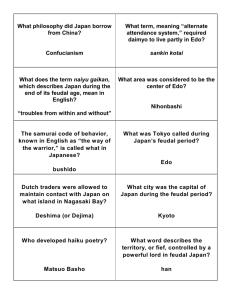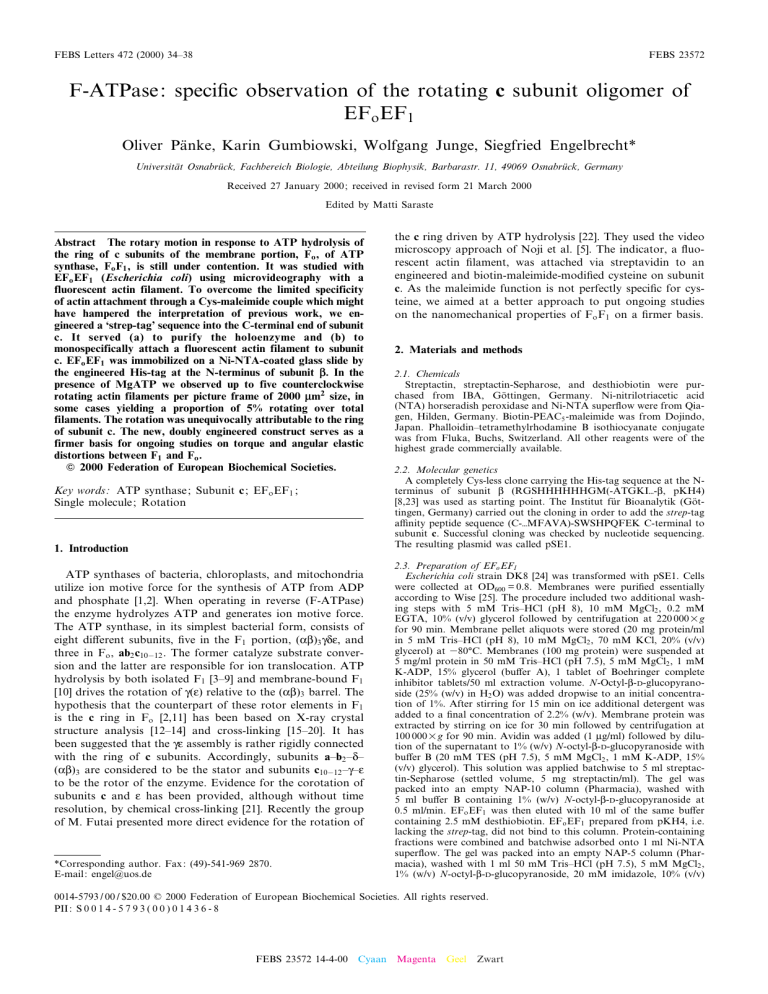
FEBS Letters 472 (2000) 34^38
FEBS 23572
F-ATPase: speci¢c observation of the rotating c subunit oligomer of
EFoEF1
Oliver Pa«nke, Karin Gumbiowski, Wolfgang Junge, Siegfried Engelbrecht*
Universita«t Osnabru«ck, Fachbereich Biologie, Abteilung Biophysik, Barbarastr. 11, 49069 Osnabru«ck, Germany
Received 27 January 2000; received in revised form 21 March 2000
Edited by Matti Saraste
Abstract The rotary motion in response to ATP hydrolysis of
the ring of c subunits of the membrane portion, Fo , of ATP
synthase, Fo F1 , is still under contention. It was studied with
EFo EF1 (Escherichia coli) using microvideography with a
fluorescent actin filament. To overcome the limited specificity
of actin attachment through a Cys-maleimide couple which might
have hampered the interpretation of previous work, we engineered a `strep-tag' sequence into the C-terminal end of subunit
c. It served (a) to purify the holoenzyme and (b) to
monospecifically attach a fluorescent actin filament to subunit
c. EFo EF1 was immobilized on a Ni-NTA-coated glass slide by
the engineered His-tag at the N-terminus of subunit L. In the
presence of MgATP we observed up to five counterclockwise
rotating actin filaments per picture frame of 2000 Wm2 size, in
some cases yielding a proportion of 5% rotating over total
filaments. The rotation was unequivocally attributable to the ring
of subunit c. The new, doubly engineered construct serves as a
firmer basis for ongoing studies on torque and angular elastic
distortions between F1 and Fo .
z 2000 Federation of European Biochemical Societies.
Key words: ATP synthase; Subunit c; EFo EF1 ;
Single molecule; Rotation
1. Introduction
ATP synthases of bacteria, chloroplasts, and mitochondria
utilize ion motive force for the synthesis of ATP from ADP
and phosphate [1,2]. When operating in reverse (F-ATPase)
the enzyme hydrolyzes ATP and generates ion motive force.
The ATP synthase, in its simplest bacterial form, consists of
eight di¡erent subunits, ¢ve in the F1 portion, (KL)3 QNO, and
three in Fo , ab2 c10ÿ12 . The former catalyze substrate conversion and the latter are responsible for ion translocation. ATP
hydrolysis by both isolated F1 [3^9] and membrane-bound F1
[10] drives the rotation of Q(O) relative to the (KL)3 barrel. The
hypothesis that the counterpart of these rotor elements in F1
is the c ring in Fo [2,11] has been based on X-ray crystal
structure analysis [12^14] and cross-linking [15^20]. It has
been suggested that the QO assembly is rather rigidly connected
with the ring of c subunits. Accordingly, subunits a^b2 ^N^
(KL)3 are considered to be the stator and subunits c10ÿ12 ^Q^O
to be the rotor of the enzyme. Evidence for the corotation of
subunits c and O has been provided, although without time
resolution, by chemical cross-linking [21]. Recently the group
of M. Futai presented more direct evidence for the rotation of
*Corresponding author. Fax: (49)-541-969 2870.
E-mail: engel@uos.de
the c ring driven by ATP hydrolysis [22]. They used the video
microscopy approach of Noji et al. [5]. The indicator, a £uorescent actin ¢lament, was attached via streptavidin to an
engineered and biotin-maleimide-modi¢ed cysteine on subunit
c. As the maleimide function is not perfectly speci¢c for cysteine, we aimed at a better approach to put ongoing studies
on the nanomechanical properties of Fo F1 on a ¢rmer basis.
2. Materials and methods
2.1. Chemicals
Streptactin, streptactin-Sepharose, and desthiobiotin were purchased from IBA, Go«ttingen, Germany. Ni-nitrilotriacetic acid
(NTA) horseradish peroxidase and Ni-NTA super£ow were from Qiagen, Hilden, Germany. Biotin-PEAC5 -maleimide was from Dojindo,
Japan. Phalloidin^tetramethylrhodamine B isothiocyanate conjugate
was from Fluka, Buchs, Switzerland. All other reagents were of the
highest grade commercially available.
2.2. Molecular genetics
A completely Cys-less clone carrying the His-tag sequence at the Nterminus of subunit L (RGSHHHHHHGM(-ATGKIT-L, pKH4)
[8,23] was used as starting point. The Institut fu«r Bioanalytik (Go«ttingen, Germany) carried out the cloning in order to add the strep-tag
a¤nity peptide sequence (C-TMFAVA)-SWSHPQFEK C-terminal to
subunit c. Successful cloning was checked by nucleotide sequencing.
The resulting plasmid was called pSE1.
2.3. Preparation of EFo EF1
Escherichia coli strain DK8 [24] was transformed with pSE1. Cells
were collected at OD600 = 0.8. Membranes were puri¢ed essentially
according to Wise [25]. The procedure included two additional washing steps with 5 mM Tris^HCl (pH 8), 10 mM MgCl2 , 0.2 mM
EGTA, 10% (v/v) glycerol followed by centrifugation at 220 000Ug
for 90 min. Membrane pellet aliquots were stored (20 mg protein/ml
in 5 mM Tris^HCl (pH 8), 10 mM MgCl2 , 70 mM KCl, 20% (v/v)
glycerol) at 380³C. Membranes (100 mg protein) were suspended at
5 mg/ml protein in 50 mM Tris^HCl (pH 7.5), 5 mM MgCl2 , 1 mM
K-ADP, 15% glycerol (bu¡er A), 1 tablet of Boehringer complete
inhibitor tablets/50 ml extraction volume. N-Octyl-L-D-glucopyranoside (25% (w/v) in H2 O) was added dropwise to an initial concentration of 1%. After stirring for 15 min on ice additional detergent was
added to a ¢nal concentration of 2.2% (w/v). Membrane protein was
extracted by stirring on ice for 30 min followed by centrifugation at
100 000Ug for 90 min. Avidin was added (1 Wg/ml) followed by dilution of the supernatant to 1% (w/v) N-octyl-L-D-glucopyranoside with
bu¡er B (20 mM TES (pH 7.5), 5 mM MgCl2 , 1 mM K-ADP, 15%
(v/v) glycerol). This solution was applied batchwise to 5 ml streptactin-Sepharose (settled volume, 5 mg streptactin/ml). The gel was
packed into an empty NAP-10 column (Pharmacia), washed with
5 ml bu¡er B containing 1% (w/v) N-octyl-L-D-glucopyranoside at
0.5 ml/min. EFo EF1 was then eluted with 10 ml of the same bu¡er
containing 2.5 mM desthiobiotin. EFo EF1 prepared from pKH4, i.e.
lacking the strep-tag, did not bind to this column. Protein-containing
fractions were combined and batchwise adsorbed onto 1 ml Ni-NTA
super£ow. The gel was packed into an empty NAP-5 column (Pharmacia), washed with 1 ml 50 mM Tris^HCl (pH 7.5), 5 mM MgCl2 ,
1% (w/v) N-octyl-L-D-glucopyranoside, 20 mM imidazole, 10% (v/v)
0014-5793 / 00 / $20.00 ß 2000 Federation of European Biochemical Societies. All rights reserved.
PII: S 0 0 1 4 - 5 7 9 3 ( 0 0 ) 0 1 4 3 6 - 8
FEBS 23572 14-4-00 Cyaan Magenta Geel Zwart
O. Pa«nke et al./FEBS Letters 472 (2000) 34^38
35
was carried out with Coomassie followed by silver [27]. ATPase activity was measured with 0.1 Wg protein, 50 mM Tris^HCl (pH 8.0),
3 mM MgCl2 , 10 mM Na-ATP, 1% N-octyl-L-D-glucopyranoside.
Typical activities under these conditions were 70 U/mg.
2.4. Preparation of F-actin
G-actin was prepared from acetone powder obtained from rabbit
skeletal muscle as described by Pardee and Spudich [28]. The protein
was brie£y soni¢ed and gel ¢ltrated against 2 mM MOPS/KOH (pH
7.0), 0.2 mM CaCl2 , 2 mM ATP (bu¡er G). Biotinylation was carried
out with a six-fold molar excess of biotin-PEAC5 -maleimide for 2 h at
ambient temperature. Excess reagent was removed by an overnight
dialysis (bu¡er G) followed by two successive gel ¢ltrations (Pharmacia PD 10/bu¡er G). This preparation was stored frozen in aliquots at
380³C. Prior to use, the thawed G-actin (18 WM) was converted into
£uorescently labeled F-actin by addition of 20 mM MOPS/KOH (pH
7.0), 100 mM KCl, 10 mM MgCl2 , 18 WM phalloidin^tetramethylrhodamine B isothiocyanate conjugate (3 h/4³C) [5]. Special care was
taken in pipetting the labeled F-actin. The ¢lament length varied
between 0.5 and 10 Wm depending on the applied shear forces.
Fig. 1. SDS electrophoresis of doubly chromatographed EFo EF1
(200 ng) on 8^25% Pharmacia Phast Gel. Staining with Coomassie
brilliant blue R250 followed by silver. This technique is, of course,
by no means quantitative [27].
glycerol and eluted with the same bu¡er containing 150 mM imidazole
resulting in 150 Wg/ml protein. Protein determination was carried out
according to Sedmak and Grossberg [26] and SDS electrophoresis
with the Pharmacia Phast system (8^25% gradient gels). Staining
2.5. Immobilization of EFo EF1
Samples were ¢lled into £ow cells consisting of two coverslips (bottom, 26U76 mm2 ; top, 21U26 mm2 ) separated by para¢lm strips.
Protein solutions were infused in the following order (2U25 Wl per
step, 4 min incubation): (1) 0.8 WM Ni-NTA-horseradish peroxidase
conjugate in 20 mM MOPS/KOH (pH 7.0), 50 mM KCl, 5 mM
MgCl2 (bu¡er R); (2) 10 mg/ml bovine serum albumin in bu¡er R;
(3) 5 nM EFo EF1 in 50 mM Tris^HCl (pH 7.5), 50 mM KCl, 5 mM
MgCl2 , 10% (v/v) glycerol, 1% (w/v) N-octyl-L-D-glucopyranoside
(bu¡er S); (4) wash with bu¡er S; (5) 0.5 WM streptactin in bu¡er
S; (6) wash with bu¡er S; (7) 200 nM biotinylated, £uorescently
labeled F-actin in bu¡er S (10 min incubation); (8) wash with bu¡er
S; (9) 20 mM glucose, 0.2 mg/ml glucose oxidase, 50 Wg/ml catalase,
0.5% 2-mercaptoethanol, 5 mM ATP in bu¡er S.
2.6. Video microscopy
An inverted £uorescence microscope (IX70, Olympus, Japan, lens
PlanApo 100U/1.40 oil, £uorescence cube MWIG) was equipped with
a silicon intensi¢ed tube camera (C 2400-08, Hamamatsu, Japan) and
connected to a VHS-PAL video recorder (25 frames/s). With this
setup ¢laments of 5 Wm length appeared as 3 cm long rods on a 14Q
Fig. 2. Scheme of the experimental set-up. A £uorescently labeled actin ¢lament^biotin^streptactin complex was connected to the engineered
strep-tags of subunit c of the immobilized EFo EF1 molecule. Probably several strep-tags were needed to form a tightly binding spoke over the
ring of subunit c. Subunits shown in blue are attributed to the stator, rotating components are drawn in red and yellow.
FEBS 23572 14-4-00 Cyaan Magenta Geel Zwart
36
O. Pa«nke et al./FEBS Letters 472 (2000) 34^38
monitor. The £ow cell was loaded with freshly extracted and chromatographed samples of EFo EF1 , labeled with actin ¢laments and single
molecule rotation was studies up to 30 min after loading. Video data
were captured (frame grabber FlashBus, Integral Technologies, USA)
and further processed by using the software ImagePro4.0 (Media Cybernetics, USA).
3. Results and discussion
Fig. 1 shows a silver-stained SDS^PAGE of the EFo EF1
preparation after consecutive strep-tag (¢rst) and His-tag af¢nity chromatography (second). All eight subunits were
Fig. 3. a: Superimposition of 25 subsequent frames (52U36 Wm2 , 40 ms duration each). The ¢ve indicated rotating actin ¢laments appear as
blurred circular spots. b: Sequential images of a rotating actin ¢lament attached to the c subunit oligomer on EFo EF1 . The ¢lament length
was 2.7 Wm and the averaged rotational speed was 0.44 rounds/s in the presence of 5 mM MgATP; every fourth frame was selected so that the
time interval between images was 160 ms. This ¢gure can be viewed as a time-lapse movie sequence at our web site (http://131.173.26.96/se/se.
html).
FEBS 23572 14-4-00 Cyaan Magenta Geel Zwart
O. Pa«nke et al./FEBS Letters 472 (2000) 34^38
present. Inversion of the given order of chromatographic steps
(¢rst His- then strep-tag) produced the loss of subunits K and
L. Samples prepared by only using strep-tag a¤nity chromatography also yielded positive results in the rotation assay,
but the occurrence of rotating single molecules was lower.
Fig. 2 illustrates the experimental set-up. Basically we followed the original protocol by Noji et al. [5] as also used in
[22]. However, by genetically engineering the strep-tag a¤nity
peptide sequence into the C-terminus of subunit c we avoided
the chemical modi¢cation of EFo EF1 with biotin-maleimide.
This was necessary since we had observed (not documented)
non-speci¢c labeling in several subunits (including Q!) upon
treatment with tetramethylrhodamine-6^maleimide of the
Cys-less mutant of EFo EF1 (obtained from plasmid pKH4
[8]). If such a side reaction occurs on subunits Q or O the actin
¢lament is connected to the `wrong' target, namely EF1 instead of EFo EF1 . The observed rotation might then be erroneously attributed to the c ring. By using two genetically engineered tags we circumvented such problems and additionally
gained puri¢cation quality (His-tag and strep-tag a¤nity chromatography) with the consequence of improved yield of rotating molecules. This is documented in Fig. 3.
Fig. 3a shows a viewing ¢eld of 52U36 Wm containing a
total of about 100 actin ¢laments. The picture represents the
superimposition of 25 video frames of 40 ms duration each.
Five ¢laments, i.e. an astoundingly high 5% of total, were
rotating (encircled). They appear blurred in the superimposition of Fig. 3a. Fig. 3b shows a series of movie frames for one
particular ¢lament. The direction of the rotation (counterclockwise) was evident from the curvature of the ¢lament,
which was elastically deformed under the in£uence of torque
generated by the enzyme and counteracted by the viscosity of
the medium. It is noteworthy that in several cases the rotation
of the ¢lament continued up to the fading of the £uorescence,
i.e. for several minutes. The high probability of detecting rotating ¢laments by the strep-tag assay aiming at subunit c
practically excluded artifacts caused by solitary EF1 .
In order to further discriminate against EF1 -dependent artifacts we checked this method in di¡erent ways. (1) Deliberate omission of either one single component of the chain NiNTA-horseradish peroxidase^strep-tagged EFo EF1 ^streptactin^biotin-F-actin prevented the binding of £uorescent F-actin, as evident from the absence of £uorescent ¢laments within
the £ow cell. (2) EF1 preparations (both Cys-containing and
Cys-free), which were not treated with biotin-maleimide, did
not immobilize £uorescent actin ¢laments at all. (3) Importantly, streptactin, a genetically engineered streptavidin, could
not substitute for streptavidin in the rotation assay (carried out
as in [5]) with biotinylated EF1 and £uorescent actin. In a side
by side experiment with the very same preparation of biotinyl(QK109C [8]) and binding of the ¢laments via
ated EFpKH7
1
streptactin or streptavidin, respectively, we observed many
rotating ¢laments with streptavidin but none with streptactin,
although many ¢laments were immobilized in both cases. One
reason for streptactin to only allow for binding of resting but
not of rotating ¢laments may be the three point mutations in
streptactin as compared with streptavidin, which cause di¡erent electrophoretic mobilities of the two proteins and suggest
slightly di¡erent tertiary structures [29]. Another reason might
be the binding of more than one molecule of streptactin to the
c ring thus allowing for several contacts with biotin on the
actin ¢lament and thereby strengthening the interactions be-
37
Fig. 4. a: Two typical time courses of the rotation of subunit c oligomer. Images of rotating actin ¢laments in the presence of 5 mM
MgATP were recorded with a silicon intensi¢ed tube camera (C
2400-08, Hamamatsu) and analyzed with the ImagePro software.
b: Rotational speed in revolutions per second as a function of the
length of the actin ¢laments. Frictional torque was calculated with
T = (4Z/3)gRL3 /(ln(L/2r)30.447), where g is angular velocity; R is
1033 Nsm32 , the viscosity of the medium; L is the length of the actin ¢lament; and r is 5 nm, the radius of the actin ¢lament [32,33].
Lines show the rotational speed (v = g/2Z) under a constant torque
of 5 pN nm (dotted line), 10 pN nm (thick line), 20 pN nm (thin
line), and 40 pN nm (dashed line).
tween the ¢lament, streptactin, and the engineered EFo EF1 . It
is also conceivable that the much weaker binding a¤nity between streptactin and biotin allowed for attachment of the
actin ¢lament, but as soon as rotation of the ¢lament started,
it was torn o¡. The binding a¤nity between biotin and streptavidin is in the range of 10314 M, whereas that of biotin/
FEBS 23572 14-4-00 Cyaan Magenta Geel Zwart
38
O. Pa«nke et al./FEBS Letters 472 (2000) 34^38
streptactin is estimated to be 1000-fold lower (Dr. Thomas
Schmidt, IBA Go«ttingen, personal communication). (4) Analogously, streptavidin could not substitute for streptactin in the
EFo EFpSE1
rotation assay, exactly as expected (cf. (3) above).
1
Taken together the high yield of rotating ¢laments (up to 5%)
and the above-mentioned controls excluded that we inadvertently observed the rotation of subunits Q and/or O in solitary
EF1 instead of that of subunit c of EFo EF1 .
Fig. 4a shows two typical time courses of rotation of the c
ring in EFo EF1 and Fig. 4b shows the rotational rate as a
function of ¢lament length. The decline of the rate as a function of ¢lament length reproduced the behavior previously
reported for the rotation of subunit Q in solitary EF1 [5^8].
The calculated torque as a function of ¢lament length (see
curves in Fig. 4b) is in the same range as previously reported.
A ¢ne analysis of the torque as function of the angular displacement is in progress.
Our approach has established beyond doubt that the rotation of the c ring of Fo was observed, as driven by ATP
hydrolysis in F1 . It cannot, however, prove that every rotating
c ring resulted from a complete EFo EF1 , i.e. one with one
copy of subunit a and two copies of subunit b, which form
the stator holding EFo and EF1 together (see Fig. 2). The
recently resolved crystal structure of yeast mitochondrial
(Fo F1 ), where the equivalents of E. coli subunits a and b2
were lacking, has demonstrated the stability of a (KL)3 QOc
ring structure without a and b2 [13]. It is well possible therefore that we observed the rotation of the c -ring in such `incomplete' EFo EF1 . Still, the corotation of QO with the c ring is
now ¢rmly established and it is very di¤cult to imagine how
the observed ATP hydrolysis-dependent rotations of subunits
Q, O, and c are related to the fully coupled function of Fo F1 if
these three subunit (assemblies) together do not constitute the
rotor.
The new, doubly engineered construct may serve as a ¢rmer
basis for ongoing studies on torque and functional elastic
distortions between F1 and Fo [30,31].
Acknowledgements: This work was supported by the Deutsche Forschungsgemeinschaft (SFB 431/D1), the HFSP organization (RG 15/
1998-M), the Fonds der chemischen Industrie and the Land Niedersachsen. Excellent technical assistance by G. Hikade is gratefully acknowledged. We are grateful to Dr. H. Noji and Prof. M. Yoshida
(TIT, Yokohama, Japan) for initiating us into their technique during
a visit by S.E. to their lab. We wish to thank Dr. T. Hisabori and
Prof. M. Yoshida for discussions and Dr. H. Lill for drawing our
attention to the strep-tag.
References
[1] Boyer, P.D. (1997) Annu. Rev. Biochem. 66, 717^749.
[2] Junge, W., Lill, H. and Engelbrecht, S. (1997) Trends Biochem.
Sci. 22, 420^423.
[3] Duncan, T.M., Bulygin, V.V., Zhou, Y., Hutcheon, M.L. and
Cross, R.L. (1995) Proc. Natl. Acad. Sci. USA 92, 10964^10968.
[4] Sabbert, D., Engelbrecht, S. and Junge, W. (1996) Nature 381,
623^626.
[5] Noji, H., Yasuda, R., Yoshida, M. and Kinosita, K. (1997) Nature 386, 299^302.
[6] Katoyamada, Y., Noji, H., Yasuda, R., Kinosita, K. and Yoshida, M. (1998) J. Biol. Chem. 273, 19375^19377.
[7] Omote, H., Sambonmatsu, N., Saito, K., Sambongi, Y., Iwamoto-Kihara, A., Yanagida, T., Wada, Y. and Futai, M. (1999)
Proc. Natl. Acad. Sci. USA 96, 7780^7784.
[8] Noji, H., Hasler, K., Junge, W., Kinosita Jr., K., Yoshida, M.
and Engelbrecht, S. (1999) Biochem. Biophys. Res. Commun.
260, 597^599.
[9] Hisabori, T., Kondoh, A. and Yoshida, M. (1999) FEBS Lett.
463, 35^38.
[10] Zhou, Y.T., Duncan, T.M., Bulygin, V.V., Hutcheon, M.L. and
Cross, R.L. (1996) Biochim. Biophys. Acta 1275, 96^100.
[11] Engelbrecht, S. and Junge, W. (1997) FEBS Lett. 414, 485^491.
[12] Abrahams, J.P., Leslie, A.G.W., Lutter, R. and Walker, J.E.
(1994) Nature 370, 621^628.
[13] Stock, D., Leslie, A.G. and Walker, J.E. (1999) Science 286,
1700^1705.
[14] Hausrath, A.C., Gru«ber, G., Matthews, B.W. and Capaldi, R.A.
(1999) Proc. Natl. Acad. Sci. USA 96, 13697^13702.
[15] Schulenberg, B., Wellmer, F., Junge, W. and Engelbrecht, S.
(1997) Eur. J. Biochem. 249, 134^141.
[16] Aggeler, R. and Capaldi, R.A. (1996) J. Biol. Chem. 271, 13888^
13891.
[17] Tang, C.L. and Capaldi, R.A. (1996) J. Biol. Chem. 271, 3018^
3024.
[18] Watts, S.D., Tang, C.L. and Capaldi, R.A. (1996) J. Biol. Chem.
271, 28341^28347.
[19] Watts, S.D., Zhang, Y., Fillingame, R.H. and Capaldi, R.A.
(1995) FEBS Lett. 368, 235^238.
[20] Zhang, Y. and Fillingame, R.H. (1995) J. Biol. Chem. 270, 87^
93.
[21] Schulenberg, B. and Capaldi, R.A. (1999) J. Biol. Chem. 274,
28351^28355.
[22] Sambongi, Y., Iko, Y., Tanabe, M., Omote, H., Iwamoto-Kihara, A., Ueda, I., Yanagida, T., Wada, Y. and Futai, M.
(1999) Science 286, 1722^1724.
[23] Kuo, P.H., Ketchum, C.J. and Nakamoto, R.K. (1998) FEBS
Lett. 426, 217^220.
[24] Klionsky, D.J., Brusilow, W.S.A. and Simoni, R.D. (1984)
J. Bacteriol. 160, 1055^1060.
[25] Wise, J.G. (1990) J. Biol. Chem. 265, 10403^10409.
[26] Sedmak, J.J. and Grossberg, S.E. (1994) Anal. Biochem. 79, 544^
552.
[27] Krause, I. and Elbertzhagen, H. (1987) in: Eine 5-Minuten
schnelle Silberfa«rbung fu«r getrocknete Polyacrylamidgele (Radola, B.J., Ed.), Elektrophoreseforum 1987, pp. 382^284, TU Munich.
[28] Pardee, J.D. and Spudich, J.A. (1982) Methods Enzymol. 85,
164^170.
[29] Voss, S. and Skerra, A. (1997) Protein Eng. 10, 975^982.
[30] Cherepanov, D., Mulkidjanian, A. and Junge, W. (1999) FEBS
Lett. 449, 1^6.
[31] Pa«nke, O. and Rumberg, B. (1999) Biochim. Biophys. Acta 1412,
118^128.
[32] Hunt, A.J., Gittes, F. and Howard, J. (1994) Biophys. J. 67, 766^
781.
[33] Yasuda, R., Noji, H., Kinosita, K. and Yoshida, M. (1998) Cell
93, 1117^1124.
FEBS 23572 14-4-00 Cyaan Magenta Geel Zwart

